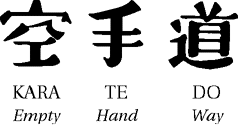KARATE HISTORY
Most Western students of Asian martial arts, if
they have done any research on the subject at all, will surely have
come across references to Bodhidharma. He is known as "Daruma" in
Japan and as often as not, this Indian Buddhist monk is cited as the
prime source for all martial arts styles or at the vary least, for
any style which traces its roots back to the fabled Shaolin Temple.
However, the question of his contributions to the martial arts and
to Zen Buddhism and even of his very existence has been a matter of
controversy among historians and martial arts scholars for many
years (Spiessbach,1992).
As legend has it, the evolution of karate began over a thousand
years ago, possibly as early as the fifth century BC when
Bodhidharma arrived in Shaolin-si (small forest temple),
China from India and taught Zen Buddhism. He also introduced a
systematized set of exercises designed to strengthen the mind and
body, exercises which allegedly marked the beginning of the Shaolin
style of temple boxing. Bodhidharma's teachings later became the
basis for the majority of Chinese martial arts. In truth, the
origins of karate appear to be somewhat obscure and little is known
about the early development of karate until it appeared in Okinawa.
Okinawa is a small island of the group that
comprises modern day Japan. It is the main island in the chain of
Ryuku Islands which spans from Japan to Taiwan. Surrounded by coral,
Okinawa is approximately 10 km (6 mi) wide and only about 110 km
(less than 70 mi) long. It is situated 740 km (400 nautical mi) east
of mainland China, 550 km (300 nautical miles) south of mainland
Japan and an equal distance north of Taiwan. Being at the crossroads
of major trading routes, its significance as a "resting spot" was
first discovered by the Japanese. It later developed as a trade
centre for southeastern Asia, trading with Japan, China, Indo China,
Thailand, Malaysia, Borneo and the Philippines.
In its earliest stages, the martial art known as "karate" was an
indigenous form of closed fist fighting which was developed in
Okinawa and called Te, or 'hand'. Weapons bans, imposed on
the Okinawans at various points in their history, encouraged the
refinement of empty-hand techniques and, for this reason, was
trained in secret until modern times. Further refinement came with
the influence of other martial arts brought by nobles and trade
merchants to the island.
The Chinese character used to write Tode
could also be pronounced 'kara' thus the name Te was replaced
with kara te - jutsu or 'Chinese hand art' by the Okinawan
Masters. This was later changed to karate-do by Gichin
Funakoshi who adopted an alternate meaning for the Chinese character
for kara, 'empty'. From this point on the term karate
came to mean 'empty hand'. The Do in karate-do means 'way' or
'path', and is indicative of the discipline and philosophy of karate
with moral and spiritual connotations.
|
 |
The first public demonstration of karate in Japan
was in 1917 by Gichin Funakoshi, at the Butoku-den in Kyoto (Hassell
1984). This, and subsequent demonstrations, greatly impressed many
Japanese, including the Crown-Prince Hirohito, who was very
enthusiastic about the Okinawan art. In 1922, Dr. Jano Kano, founder
of the Japanese art of Judo, invited Funakoshi to demonstrate at the
famous Kodokan Dojo and to remain in Japan to teach karate. This
sponsorship was instrumental in establishing a base for karate in
Japan. As an Okinawan "peasant art," karate would have been scorned
by the Japanese without the backing of so formidable a martial arts
master (Maliszewski, 1992).
Today there are four main styles of karate-do in Japan: Goju-ryu,
Shito-ryu, Shotokan, and Wado-ryu:
Goju-ryu developed out of Naha-te, its popularity primarily
due to the success of Kanryo Higaonna (1853-1915). Higaonna opened a
dojo in Naha using eight forms brought from China. His best
student, Chojun Miyagi (1888-1953) later founded Goju-ryu,
'hard soft way' in 1930. In Goju-ryu much emphasis is placed on
combining soft circular blocking techniques with quick strong
counter attacks delivered in rapid succession.
Shito-ryu was founded by Kenwa Mabuni (1889-1952) in 1928 and
was influenced directly by both Naha-te and Shuri-te. The name
Shito is constructively derived from the combination of the
Japanese characters of Mabuni's teachers' names - Ankoh Itosu and
Kanryo Higaonna. Shito-ryu schools use a large number of kata, about
fifty, and is characterized by an emphasis on power in the execution
of techniques.
Shotokan was founded by Gichin Funakoshi (1868-1957) in Tokyo
in 1938. Funakoshi is considered to be the founder of modern karate.
Born in Okinawa, he began to study karate with Yasutsune Azato, one
of Okinawa's greatest experts in the art. In 1921 Funakoshi first
introduced Karate to Tokyo. In 1936, at nearly 70 years of age, he
opened his own training hall. The dojo was called Shotokan
after the pen name used by Funakoshi to sign poems written in his
youth. Shotokan Karate is characterized by powerful linear
techniques and deep strong stances.
Wado-ryu, 'way of harmony', founded in 1939 is a system of
karate developed from jujitsu and karate by Hienori Otsuka as taught
by one of his instructors, Gichin Funakoshi. This style of karate
combines basic movements of jujitsu with techniques of evasion,
putting a strong emphasis on softness and the way of harmony or
spiritual discipline.
|
![]()
![]()
![]()

![]()
![]()
![]()
![]()
![]()
![]()
![]()
![]()
![]()
![]()
![]()
![]()
![]()
